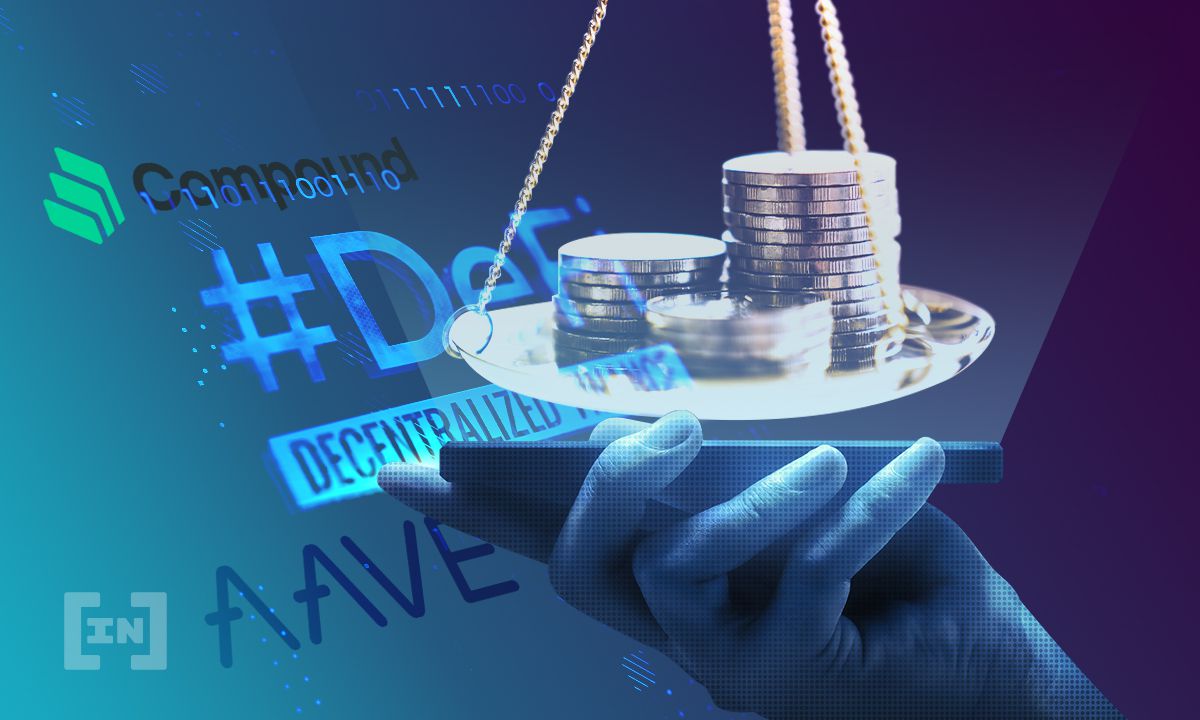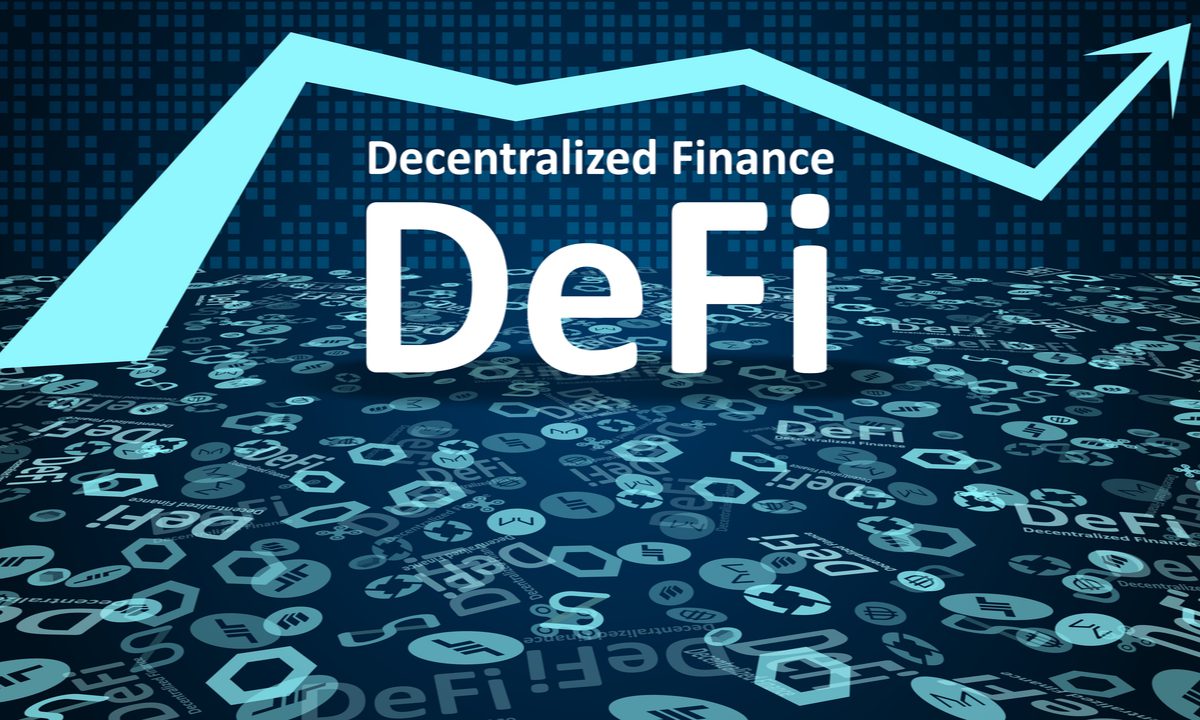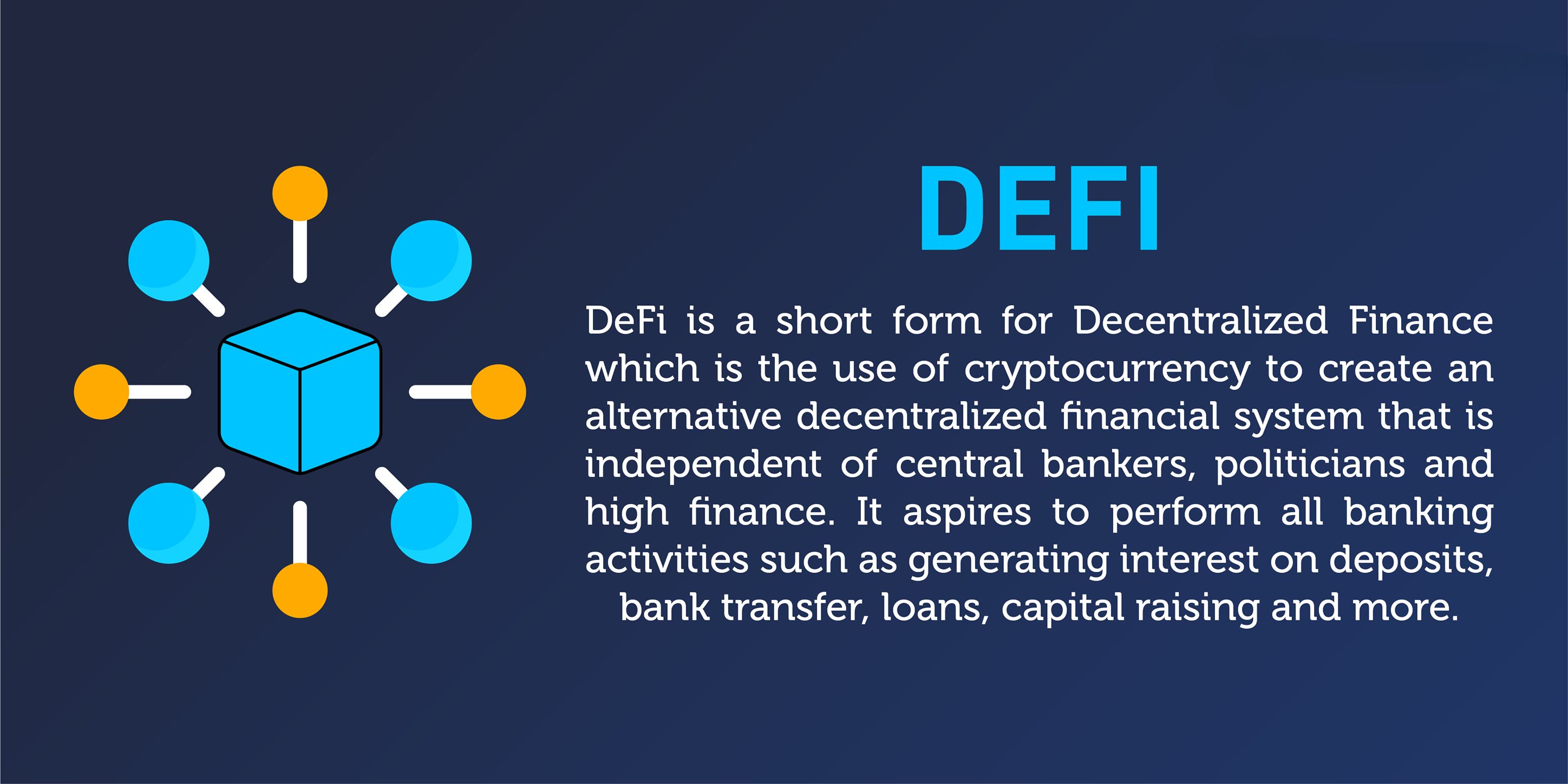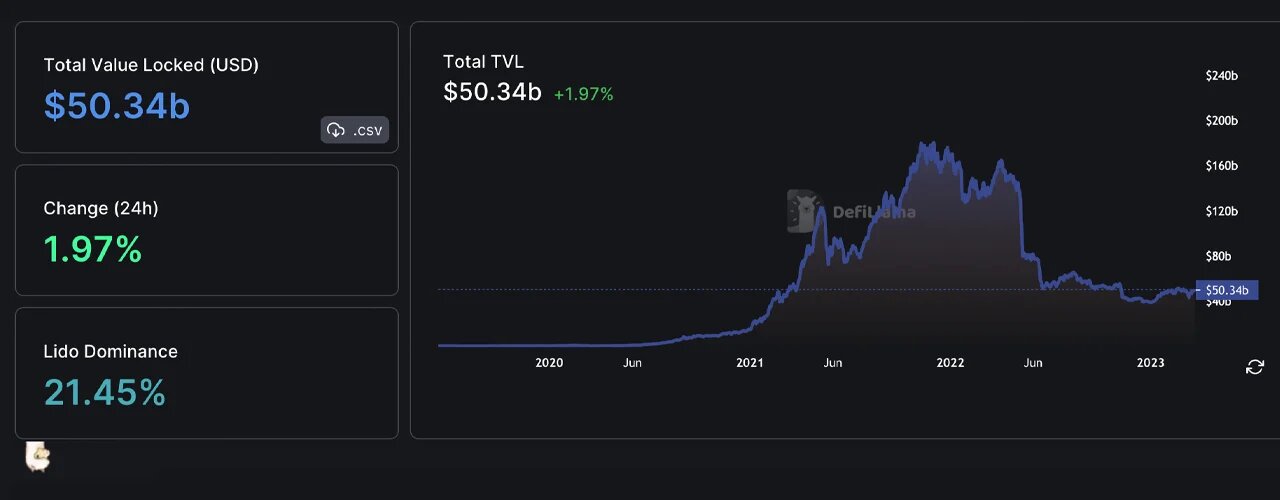Introduction
Welcome to the world of decentralized finance (DeFi) lending! In recent years, the rise of blockchain technology has paved the way for innovative financial solutions that operate outside the traditional banking system. DeFi lending is one of these groundbreaking concepts that is transforming the way we borrow and lend money.
Unlike traditional lending, which involves intermediaries such as banks, DeFi lending eliminates the need for middlemen by using smart contracts. These self-executing contracts facilitate secure and transparent transactions on the blockchain, allowing borrowers and lenders to connect directly without relying on a centralized institution.
The decentralized nature of DeFi lending brings numerous benefits to both borrowers and lenders. Borrowers can access loans quickly and securely, often without having to go through lengthy approval processes or provide extensive documentation. On the other hand, lenders can earn passive income by lending out their funds and potentially achieving higher returns compared to traditional savings accounts.
Additionally, DeFi lending opens up opportunities for individuals who may not have access to traditional banking services. It promotes financial inclusion by allowing anyone with an internet connection to participate in lending and borrowing activities, regardless of their geographical location or socioeconomic background.
However, it is important to note that DeFi lending is not without its risks. The decentralized nature of the technology also means that there is no central authority to oversee transactions or guarantee the safety of funds. As a participant, it is crucial to exercise due diligence, understand the risks involved, and choose reputable platforms for your lending and borrowing activities.
In this article, we will delve deeper into the world of DeFi lending. We will explore how it works, the role of smart contracts, how to participate, considerations for choosing the right platform, collateralization, interest rates, loan repayment, and important risks to be aware of. By the end, you will have a comprehensive understanding of DeFi lending and be empowered to make informed decisions in this exciting financial frontier.
What is DeFi Lending?
DeFi lending, also known as decentralized lending, refers to the practice of borrowing and lending funds through decentralized platforms built on blockchain technology. These platforms use smart contracts to facilitate transparent and automated lending transactions, eliminating the need for intermediaries such as banks.
In traditional lending, when someone needs to borrow money, they typically approach a bank or financial institution that acts as an intermediary. The institution assesses their creditworthiness and, if approved, provides the funds while charging interest. DeFi lending disrupts this model by enabling borrowers and lenders to connect directly through decentralized platforms, bypassing the traditional banking system.
To participate in DeFi lending, borrowers would deposit collateral in the form of digital assets, such as cryptocurrencies, into a smart contract. The collateral acts as security for the loan and mitigates the risk for lenders. Once the collateral is deposited, the borrower can receive a loan in the form of a digital asset, which is typically a percentage of the value of the collateral.
The smart contract governing the lending process establishes the terms of the loan, including the loan amount, interest rate, and repayment schedule. The contract also enforces the repayment by automatically deducting the due amount from the borrower’s collateral or wallet.
Lenders, on the other hand, provide liquidity to the lending platform by depositing their funds into the platform’s reserve pool. By doing so, lenders can earn passive income in the form of interest, which is paid by the borrowers. The interest rates offered in DeFi lending are often determined by supply and demand dynamics and can be more favorable compared to traditional lending rates.
One of the key advantages of DeFi lending is the accessibility it offers. Anyone with an internet connection and a digital wallet can participate, regardless of their location. This enables people who are underserved by traditional banking systems or excluded due to various reasons to access loans and earn interest on their funds.
In summary, DeFi lending is a disruptive financial innovation that leverages blockchain technology to enable direct borrowing and lending without intermediaries. By utilizing smart contracts and digital collateral, participants can access loans, earn interest, and experience a more inclusive and transparent financial ecosystem.
Understanding Smart Contracts
At the core of DeFi lending is the use of smart contracts. A smart contract is a self-executing contract with the terms of the agreement encoded directly into the blockchain. It operates autonomously and enforces the rules and conditions defined within the contract. This technology removes the need for middlemen and enables trustless and transparent transactions in DeFi lending.
Smart contracts are built using programming languages, most commonly Solidity for Ethereum-based projects. They contain a set of predefined conditions that must be met for the contract to execute. Once deployed on the blockchain, the smart contract becomes immutable and cannot be altered.
In the context of DeFi lending, smart contracts play a crucial role in facilitating and automating the lending process. They manage the interaction between borrowers and lenders, ensuring that all parties adhere to the agreed-upon terms.
When a borrower wants to obtain a loan, they deposit collateral into the smart contract. The contract calculates the loan-to-value (LTV) ratio based on the value of the collateral and determines the maximum amount that can be borrowed. This step eliminates the need for credit checks and minimizes the risk for lenders.
Once the loan amount is determined, the smart contract holds the collateral as security. It sets the terms of the loan, including the interest rate, duration, and repayment schedule. The smart contract also automates the deduction of interest payments and principal repayments from the borrower’s collateral or wallet.
Smart contracts provide transparency and security to participants in DeFi lending. Each transaction and balance update is recorded on the blockchain, providing an immutable audit trail. Additionally, smart contracts remove the need for trust between the borrower and the lender, as the contract enforces the agreed-upon conditions automatically without the need for human intervention.
It is important to note that while smart contracts are designed to be secure, they are not immune to bugs or vulnerabilities. Flaws in the contract’s code can potentially be exploited and result in financial loss. Therefore, it is crucial for developers to undergo thorough testing and for participants to carefully assess the security measures in place before engaging in DeFi lending activities.
In summary, smart contracts are the backbone of DeFi lending, providing the automation, transparency, and security that make this financial innovation possible. As decentralized technologies continue to evolve, smart contracts will undoubtedly play a central role in revolutionizing various aspects of the financial industry.
How to Participate in DeFi Lending
Participating in DeFi lending requires a few essential steps to get started. To engage in lending or borrowing activities, follow the guide below:
1. Set up a Digital Wallet: Start by setting up a digital wallet that is compatible with the blockchain platform you wish to use for DeFi lending. There are various wallet options available, including browser extensions, mobile apps, and hardware wallets. Ensure that you choose a wallet that offers the necessary security features and supports the tokens you intend to use.
2. Select a DeFi Lending Platform: Research and choose a reliable DeFi lending platform that aligns with your lending or borrowing goals. Consider factors such as platform reputation, supported assets, interest rates, loan terms, and user experience. Popular DeFi lending platforms include Compound, Aave, and MakerDAO. Explore and compare the features offered by different platforms before making a decision.
3. Deposit Funds: Once you have chosen a platform, deposit the funds you intend to lend or use as collateral. Ensure that the platform supports the tokens you wish to deposit. Depending on the platform, you may need to wrap or convert your tokens into the native token of the platform.
4. Choose the Lending Option: Decide whether you want to lend your funds or borrow from the platform. If you choose to lend, deposit your funds into the lending pool provided by the platform. By doing so, you will start earning interest on your deposited funds. If you wish to borrow, specify the amount you need and provide the required collateral. The platform will determine the loan terms based on the value of your collateral.
5. Monitor Your Investment: Keep an eye on your lending or borrowing activities. Monitor the interest rates, market conditions, and the performance of the platform. Regularly check your investment and adjust your strategy if needed. Stay informed about any updates, changes, or new features introduced by the platform.
6. Repay Your Loan: If you have borrowed funds, make sure to adhere to the repayment schedule defined by the smart contract. Repay the principal and interest according to the terms agreed upon. Failure to repay the loan on time may result in liquidation of your collateral and loss of funds.
7. Stay Informed and Assess Risks: As with any investment or financial activity, it is crucial to stay informed about the risks involved in DeFi lending. Be aware of potential vulnerabilities, smart contract risks, and market fluctuations. Only invest what you can afford to lose and consider diversifying your lending or borrowing activities across multiple platforms to mitigate risk.
By following these steps, you can actively participate in the exciting world of DeFi lending. Remember to conduct thorough research, be mindful of the risks involved, and choose reputable platforms to ensure a secure and rewarding lending or borrowing experience.
Choosing the Right Platform
Selecting the right DeFi lending platform is crucial to ensure a secure and satisfactory lending experience. With the increasing number of platforms available, it is essential to consider several factors before making a decision. Here are some key considerations when choosing a DeFi lending platform:
1. Reputation and Security: Research the platform’s reputation within the crypto community. Look for platforms that have a solid track record, positive user feedback, and a transparent governance model. Consider the security measures they have in place to protect user funds and data. Platforms with audited smart contracts and robust security protocols are preferable.
2. Supported Assets: Check if the platform supports the assets you wish to lend or borrow. Different platforms have different lending pools and supported tokens. Ensure that the assets you want to use align with the platform’s offerings to make the most of your lending or borrowing strategy.
3. Interest Rates and Loan Terms: Compare the interest rates and loan terms offered by different platforms. Some platforms may provide competitive rates that can maximize your earnings as a lender or offer favorable borrowing terms. Consider the flexibility of loan durations and repayment options, as well as any additional fees associated with borrowing or lending.
4. Platform User Experience: Evaluate the user experience of the platform. Look for an intuitive interface, easy navigation, and well-designed features. A user-friendly platform will make it more convenient for you to manage your lending or borrowing activities.
5. Liquidity and Loan Demand: Assess the platform’s liquidity and loan demand. A platform with high liquidity ensures that you can easily enter or exit positions without significant slippage. Additionally, a platform with a steady loan demand indicates a vibrant lending ecosystem, enhancing the potential for earning interest as a lender.
6. Governance and Decision-Making: Understand the governance model of the platform. Some platforms allow users to participate in decision-making through voting or staking mechanisms. Consider if you want to be involved in the platform’s governance and have a say in its future direction.
7. Transparency and Audits: Look for platforms that prioritize transparency by providing information about their team, development roadmap, and financial audits. Public audits conducted by reputable blockchain security firms can help validate the platform’s security measures and instill confidence in users.
8. Community and Support: Consider the platform’s community and support system. Engaging with an active and supportive community can provide valuable insights and assistance when needed. Look out for platforms that prioritize user support and have a responsive customer service team.
By carefully considering these factors, you can make an informed decision when choosing a DeFi lending platform. Take the time to research and evaluate different options, and remember to regularly assess the platform’s performance and any updates or changes that may affect your lending or borrowing activities.
Collateralization and Loan-to-Value (LTV) Ratio
Collateralization and Loan-to-Value (LTV) ratio are key concepts in DeFi lending that determine the amount borrowers can borrow in relation to the value of their collateral. Understanding these terms is essential when participating in DeFi lending platforms. Let’s explore these concepts in more detail:
Collateralization: In DeFi lending, borrowers provide collateral to secure their loans. Collateral acts as a form of security for lenders, reducing the risk of default. The collateral can be in the form of cryptocurrencies or other digital assets accepted by the lending platform. The value of the collateral should be higher than the loan amount borrowed, ensuring that lenders have a buffer in case of price fluctuations.
Loan-to-Value (LTV) Ratio: The Loan-to-Value (LTV) ratio indicates the maximum percentage of a digital asset’s value that can be borrowed against as a loan. LTV ratios vary between different lending platforms and can be set by the platform itself or determined by market demand and available liquidity. For example, if a platform has an LTV ratio of 50%, a borrower can borrow up to 50% of the value of their collateral.
The LTV ratio is a crucial factor for both lenders and borrowers. Lenders need to assess the LTV ratios offered by different platforms to determine the level of risk they are comfortable with. Platforms with lower LTV ratios provide more security for lenders but may offer lower returns. On the other hand, higher LTV ratios offer the potential for higher returns but come with increased risk.
Borrowers must also consider the LTV ratio when selecting a platform. A low LTV ratio means they will need to provide a higher amount of collateral to borrow the desired funds. On the other hand, a high LTV ratio allows borrowers to borrow more funds with a lower collateral requirement. However, borrowers need to be mindful of potential liquidation risks if the value of their collateral decreases significantly.
It is important to understand that LTV ratios can fluctuate depending on market conditions and the value of the collateral. Lenders and borrowers should closely monitor the LTV ratios on the platform they are using to ensure they maintain an appropriate level of collateralization.
Furthermore, borrowers should consider the volatility of the collateral assets when determining the amount of collateral to provide. Highly volatile assets may require higher collateralization to account for potential price fluctuations and minimize the risk of liquidation.
In summary, collateralization and Loan-to-Value (LTV) ratios are fundamental concepts in DeFi lending. Collateral provides security for lenders and enables borrowers to access funds based on the value of their assets. Understanding and considering the LTV ratio is crucial for both lenders and borrowers to assess risk levels and make informed decisions in the DeFi lending space.
Interest Rates and Borrowing Costs
Interest rates are a key component of DeFi lending, determining the cost of borrowing for participants. In the decentralized finance (DeFi) ecosystem, interest rates are typically determined by supply and demand dynamics within lending pools. Let’s take a closer look at interest rates and borrowing costs in DeFi lending:
Interest Rates: Unlike traditional lending, where interest rates are set by centralized institutions, DeFi lending platforms utilize algorithms and market dynamics to determine interest rates. Interest rates can fluctuate based on factors such as the demand for borrowing or lending, market conditions, and available liquidity in the lending pools.
Generally, lenders earn interest on their deposited funds, while borrowers pay interest on the amount they borrow. Interest rates in DeFi lending are often expressed as annual percentage yield (APY) or annual percentage rate (APR) to provide borrowers and lenders with a clear understanding of the borrowing and lending costs.
Borrowing Costs: Borrowing costs in DeFi lending consist of the interest paid by borrowers and any additional fees imposed by the lending platform. The interest rate charged to borrowers depends on factors including the platform’s lending pool dynamics, the level of demand for borrowing, the borrower’s creditworthiness (assessed through collateralization), and the duration of the loan.
It is important for borrowers to carefully consider the interest rates offered by different platforms before choosing where to borrow. Higher interest rates may impact the affordability of the loan, while lower interest rates can lead to lower borrowing costs.
In addition to interest rates, borrowers should be aware of any additional fees charged by the lending platform. These fees may include origination fees, liquidation fees (charged if collateral value drops below a threshold), and transaction fees for interacting with the smart contract on the blockchain.
Lender Earnings: Lenders in DeFi lending earn interest on their deposited funds in lending pools. The interest earned can vary depending on the lending platform and the supply and demand dynamics within the lending pool. It is important to note that earning potential may be influenced by factors such as the amount of funds provided, liquidity in the lending pool, and the interest rates offered by the platform.
To optimize earnings, lenders can consider factors such as the stability and security of the lending platform, the interest rates offered, and the diversity of the lending pool. Diversifying lending across multiple platforms and assets can help spread risk and potentially increase overall returns.
When participating in DeFi lending, borrowers and lenders should carefully evaluate the interest rates and borrowing costs involved. Conduct thorough research on different platforms, compare interest rates, consider any additional fees, and assess the risks associated with the lending platform before engaging in lending or borrowing activities.
By considering these factors, individuals can make informed decisions and achieve their financial goals while participating in the exciting world of DeFi lending.
Repaying the Loan
Repaying the loan is a crucial aspect of DeFi lending that borrowers must carefully manage to avoid any penalties or potential loss of collateral. Let’s explore the process of loan repayment in DeFi lending:
Loan Terms: When borrowing from a DeFi lending platform, borrowers agree to specific loan terms defined by the smart contract. These terms include the loan duration, interest rate, and repayment schedule. It is important for borrowers to fully understand and adhere to these terms to ensure timely repayment.
Scheduled Repayments: The smart contract will enforce scheduled repayments according to the agreed-upon terms. The amount to be repaid typically comprises both the principal amount borrowed and the accumulated interest. Repayments are often made in the form of the borrowed asset, although some platforms may allow repayment using different assets accepted by the platform.
Automatic Deductions: The repayment process is usually automated through the smart contract. The smart contract deducts the due repayment amount, including principal and interest, from the borrower’s collateral or wallet. This automated deduction ensures that borrowers fulfill their repayment obligations without the need for manual intervention.
Early Repayment: Some DeFi lending platforms offer the option of early loan repayment. This allows borrowers to repay the loan before the scheduled repayment date. Early repayment can be advantageous for borrowers as it reduces the interest accrued and potentially frees up collateral for other purposes. However, borrowers should check if there are any penalties or fees associated with early repayment before deciding to proceed.
Liquidation Risk: Failure to repay the loan or maintain the required collateralization can result in liquidation by the lending platform. If the value of the collateral drops below a certain threshold, the platform may liquidate the collateral to recover the lender’s funds. This can have significant financial implications for borrowers, potentially resulting in the loss of their collateral and additional penalties.
Managing Repayment: To effectively manage loan repayment, borrowers should ensure they have enough funds available at each scheduled repayment interval. Monitoring the loan status and repayment schedule is important to avoid missing payments. Additionally, borrowers should keep up to date with any changes in interest rates or loan terms on the lending platform to adjust their repayment strategy accordingly.
It is essential for borrowers to carefully plan and budget for loan repayment obligations in DeFi lending. Diligent management of loan repayments helps borrowers fulfill their obligations, maintain a positive credit history within the DeFi ecosystem, and safeguard their collateral.
By considering these factors and staying proactive in loan repayment, borrowers can navigate the DeFi lending landscape effectively and minimize the risks associated with loan default or liquidation.
Risks and Considerations
While DeFi lending offers numerous benefits and opportunities, it is important to be aware of the risks and considerations associated with participating in this decentralized financial ecosystem. Understanding these risks can help you make informed decisions and minimize potential negative outcomes. Let’s explore some of the key risks and considerations in DeFi lending:
Smart Contract Risks: Smart contracts, while designed to be secure and autonomous, are not infallible. Bugs or vulnerabilities in the contract’s code can potentially be exploited, resulting in financial loss. It is crucial to assess the security measures taken by the lending platform and evaluate auditing reports conducted by reputable firms to mitigate the risks associated with smart contract vulnerabilities.
Market Volatility: The cryptocurrency market is known for its volatility. The value of collateral and borrowed assets can fluctuate rapidly, which can impact borrowing costs, collateral liquidation, and potentially result in financial loss. It is important to consider the inherent volatility of the market and the potential risks it poses when participating in DeFi lending.
Liquidation Risk: If the value of the collateral falls below the required threshold, lenders may liquidate the collateral to recover their funds, resulting in the loss of collateral for the borrower. Proper risk management and monitoring the value of collateral can help mitigate the potential liquidation risk, but it is crucial to be aware of this possibility when engaging in DeFi lending.
Regulatory Uncertainty: The regulatory landscape surrounding cryptocurrencies and DeFi is constantly evolving. Regulatory changes or restrictions imposed by governing bodies can impact the availability and operation of DeFi lending platforms. It is important to stay informed about regulatory developments and assess the legal compliance of the platforms you choose to participate in.
Counterparty Risk: While DeFi lending eliminates the need for intermediaries, it introduces a different type of counterparty risk. Participants are exposed to the risk of default by other users in the lending ecosystem. It is crucial to consider the reputation and credibility of the platform and borrowers/lenders before engaging in lending activities to minimize counterparty risks.
Platform Risks: Not all DeFi lending platforms are created equal. There is a risk of fraudulent or malicious platforms operating in the market. Conduct thorough research on the platform’s reputation, security measures, and track record before depositing funds or leveraging collateral. Engaging with well-established and community-vetted platforms can help mitigate platform-specific risks.
Operational Risks: DeFi lending platforms are reliant on technology, and operational risks such as system outages, hacking attempts, or network congestion can impact the functionality and security of the platform. It is important to assess the robustness of the platform’s infrastructure, security practices, and contingency measures to mitigate operational risks.
Financial Loss: Engaging in DeFi lending involves financial risk. The value of collateral, borrowed assets, and returns on lending activities are subject to market dynamics and can lead to financial loss. It is essential to only invest funds that you can afford to lose and to diversify your lending activities to minimize the impact of potential losses.
By being aware of these risks and considerations, participants in DeFi lending can make informed decisions and put in place appropriate risk-management strategies. Conducting thorough research, diversifying lending activities, and staying up to date with market conditions can help mitigate potential risks and navigate this exciting but evolving landscape of decentralized finance.
Conclusion
Decentralized finance (DeFi) lending presents a new frontier in the financial world, revolutionizing the way we borrow and lend money. Through the use of smart contracts and blockchain technology, DeFi lending eliminates intermediaries, provides greater accessibility, and offers potentially higher returns for lenders.
In this article, we have explored the fundamentals of DeFi lending, including the concept of decentralized lending, the role of smart contracts, and how to participate in this ecosystem. We have also discussed important considerations such as choosing the right platform, understanding collateralization and Loan-to-Value (LTV) ratios, managing interest rates and borrowing costs, and repaying the loan.
It is important to acknowledge the risks and considerations associated with DeFi lending, such as smart contract vulnerabilities, market volatility, liquidation risks, regulatory uncertainties, and platform risks. By understanding these risks and implementing proper risk management strategies, participants can navigate the world of DeFi lending with confidence.
DeFi lending offers a more inclusive and accessible alternative to traditional banking systems, empowering individuals to borrow funds and earn passive income in a decentralized manner. However, it is crucial to conduct thorough research, assess platforms and risks, and exercise caution when participating in lending or borrowing activities.
As the DeFi ecosystem continues to evolve, it is essential to stay informed and adapt to the changing landscape. Stay updated on platform developments, market trends, and regulatory changes to make well-informed decisions in the world of DeFi lending.
By balancing the potential rewards with the inherent risks, individuals can harness the benefits of DeFi lending while mitigating potential pitfalls. With careful consideration, prudent risk management, and a proactive approach, participants can actively engage in DeFi lending and contribute to the growth and advancement of decentralized finance.

























